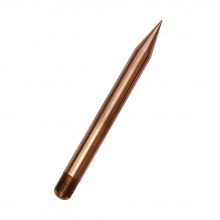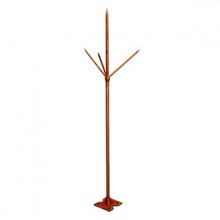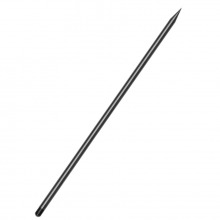The Franklin air terminal is the most common and historically well-known lightning rod due to its simplicity. It can be manufactured in different shapes, materials, and dimensions.
REQUEST MORE INFORMATION
Termination rods are suitable for external lightning protection. It can be used as a single sensor element or part of passive protection, complementing the protection conductive mesh (Faraday cages). Made of AISI 316L stainless steel or copper.
STANDARDS:
To design an effective lightning protection system with Franklin rods or capturing meshes, the following rules shall apply:
- IEC 62305:2013 Lightning protection (Parts 1, 2, 3 y 4).
- UNE - EN 62305:2011 Protection against lightning (Parts 1, 2, 3 y 4).
- NFPA 780:2014 Standard for the installation of lightning protection systems.
In addition to these rules, legislation may exist in each country to be taken into account.
RISK CALCULATION
INGESCO has an online tool that allows risk calculation according to IEC 62305 (Part 2), which allows the calculation of risk and the implementation of protective measures quickly and easily.
Calculation methods of the protection zone
Accepted methods for determining the area of passive protection systems according to IEC 62305 (Part 3) are:
Protective angle method
It is a best-suited method for buildings with simple shapes, although it is limited to a maximum height for the level of protection applied (See graph).
The volume of protection resulting from the application of the protection angle method in a termination rod is shown in the central image.
Once calculated, the different angles of protection of the termination rods that make up the system verify that the building is fully protected.



Rolling sphere method and the mesh method
When a structure has a height higher than indicated in Figure 5, the protection angle method is not applicable. For these cases, IEC 62305-3 indicates to use of: rolling sphere method (valid for all types of buildings), or mesh method (indicated when flat surfaces are protected)
Applying the rolling sphere method. The location of the capture system (point or mesh) is adequate if any point of the protected structure comes into contact with a notional sphere of radius r (see Table).


| Método de protección | ||
|---|---|---|
| Clase de SPCR | Radio de esfera rodante r (m) | Tamaño de la malla Wm (m) |
| I | 20 | 5x5 |
| II | 30 | 10x10 |
| III | 45 | 15 x 15 |
| IV | 60 | 20 x 20 |
Taller structures remaining above the Faraday cage should be protected with lightning rods.





